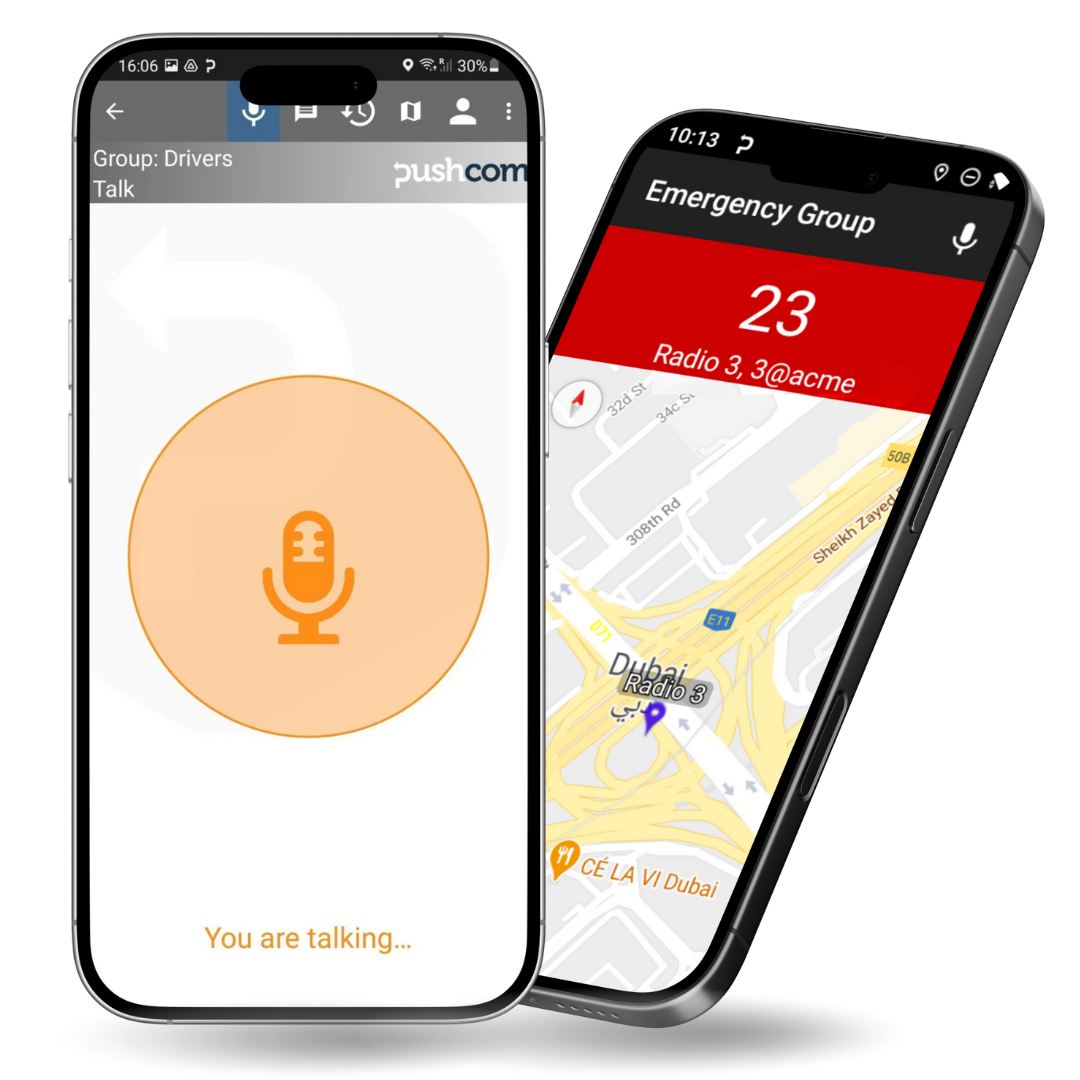

PUSHCOM
Stay Connected Anywhere, Anytime
Advanced push-to-talk communication platform for families, groups, and organizations worldwide
Professional Push-to-Talk Communication Solutions
Reliable, instant voice communication for businesses and groups of all sizes.
Features
-

Group audio
-

Group messaging
-

Map and location history
-

Call replays and message history
-

Lone worker and emergency
-

NSA proof Encryption
-

Works on any IP network
-

Mobile App for Android
-

Global coverage
-

Patrol and Time Attendance
-

Dispatcher
-

Web Admin
-

Group Management
-

Reports and Archives
-

24h Support

Who we serve:
Groups
Short-term communication solutions for pilgrimages, elections, family gatherings, and events.
Businesses
Enterprise-grade push-to-talk solutions for industries including security, construction, logistics, ports & airports, and more.
Enterprise-Grade Reliability
Always-On Availability
Built-in N : 1 High-Availability clusters plus servers in multiple regions keep Pushcom up and running—even if a whole data-centre goes offline.
Unlimited Scalability
The MCPTT core scales from the first user to millions of live accounts. Already verified on 1 400+ Android devices, so you can add teams or hardware without re-engineering.
Live in 24 Hours
Choose instant cloud delivery (active in minutes) or an on-prem ISO image that is fully operational within 24 hours—fast ROI, zero project overruns.
Standards-Built Security
Conforms to 3GPP, ETSI and IETF mission-critical standards, with all traffic protected by AES-256 over TLS 1.3—meeting telecom-grade security from day one.
Any network, anywhere
Operates on 2 G–5 G, Wi-Fi, and satellite links and supports global free roaming—insert a local SIM anywhere in the world and stay connected with zero hidden fees.
Ready to Get Started?
Join thousands of organizations worldwide who trust PUSHCOM for their communication needs.
FAQs
-
Push-to-Talk (PTT) is similar to a PMR/walkie-talkie or two-way radio, where one presses the button and talks, and others in the same channel/group hear speech without needing to answer. The main difference between PTT and a PMR/walkie-talkie is that PTT uses existing mobile data, but a PMR/walkie-talkie requires its own dedicated network.
Key advantages of PTT compared to PMR are that it’s globally available from day one, does not require a dedicated radio frequency, and runs on normal Android phones instead of expensive, dedicated handsets.
In a normal PTT call, only one person at a time can talk. Talk-time is limited; usual configurations are 30-120 seconds, after which the system cancels the call so that others can talk in turn.
In addition to group and private PTT calls, which are walkie-talkie-type one-directional, there is a special call mode called a full-duplex call, which is similar to a GSM call or Skype, and both can talk simultaneously without pressing the PTT button.
In a PMR/walkie-talkie, such as VHF, there are a limited number of channels. In PTT there are an unlimited number of groups.
A user must belong to at least one group, but he/she can belong to several groups also.
PTT can use any available IP (Internet Protocol) network to transmit data, including all generations of mobile-data networks (2G, 3G, and 4G/LTE), as well as Wi-Fi or a wired internet connection.
However, MCPTT mode—if enabled—requires LTE or fast Wi-Fi; it does not work on 2G/3G networks.
-
First generation PoC, (introduced ~2004) was a system that was governed by network operaters and it worked only in cellular network, standardized by Open Mobile Alliance (OMA), project led by Nokia, Ericsson and Motorila. WT released and deployed first OMA-compliant PoC-server 2004, and successfully participated in OMA Interoperability test at 2005.
PTT is generic name covering both solutions based on telco-standards and various proprietary implementation: examples include iDEN, VHF/UHF and various IP/data-based non-standard solution.
MCPTT new global standard, which will replace legacy group communication systems, such as VHF, TETRA, P25, iDEN and others.Key-advatage is that MCPTT is based on LTE-architecture and will be available for both, goverments/public safety as well as commercial users. This market-approach drives costs down due to economies of scale. Sharing network-infrastructure with commercial users ensure adequate capacity for emergency situation, where public safety will have priority over commercial users.3GPP has been focused on network infrastructure. Client-side is left up to manufacturers to design and implement according to the market requirements.
-
PUSHCOM/PTT system consist of following:
Smartphone with PUSHCOM client application
Server-software in internet (in cloud, organization server, or private cloud)
Network connection over mobile data or WIFI
PTT uses mobile phone networks rather than radio base stations. When PTT call is made, instead of making phone-call, voice is transmitted over data-connection, similarly to Voice over IP (VoIP), from client-application to server. Server copy audio-stream in realtime to all online-users who belong to same group. Group-members hear audio automatically from loudspeaker, without need to answer.
-
Android 5.1 or newer on phones, tablets, and computers
Windows 10 or Windows 11 (64-bit version)
Linux (64-bit version with kernel 4.0 or newer) – all distributions supported
-
PUSHCOM can increase revenue due to more efficient resource allocation and save money due to cost-effective communication system compared to legacy group-communication systems, such as walkie-talkie, TETRA, AP25 or iDEN.
It will be available nation-wide from day-1, and can be used as cloud-service, so the initial costs are close to zero.
It can play a key part in workforce management and hence drive greater efficiencies to allow staffing and operational costs to be reduced.




